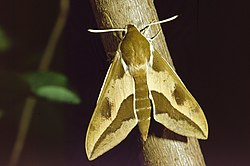List - Sphinx euphorbiaeLinnaeus, 1758
- Sphinx esulaeHufnagel, 1766
- Deilephila esulaeBoisduval, 1834
- Celerio euphorbiae conspicuaRothschild & Jordan, 1903
- Celerio euphorbiae giganteomaculataGehlen, 1930
- Celerio euphorbiae nigrofasciataIgel, 1928
- Celerio euphorbiae decolorata(Closs, 1913)
- Celerio euphorbiae cyparissiaeSchultz, 1903
- Celerio euphorbiae cyaneaWladasch, 1929
- Celerio euphorbiae conspicuataBandermann, 1926
- Celerio euphorbiae confusa(Wladasch, 1939)
- Celerio euphorbiae clossiHannemann, 1917
- Celerio euphorbiae cleopatra(Wladasch, 1931)
- Celerio euphorbiae clementiaeBayard, 1928
- Celerio euphorbiae canarinaWladasch, 1924
- Celerio euphorbiae caecigenaBandermann, 1924
- Celerio euphorbiae brunnescensSchultz, 1904
- Celerio euphorbiae bilineaSchultz, 1904
- Celerio euphorbiae bandermanniWladasch, 1933
- Celerio euphorbiae atrolimbataDannehl, 1929
- Celerio euphorbiae argustanaBandermann, 1928
- Celerio euphorbiae apiciplagaGehlen, 1930
- Celerio euphorbiae annellataCloss, 1915
- Celerio euphorbiae angustefasciata(Villarrubia, 1974)
- Celerio euphorbiae ancestralis(Wladasch, 1939)
- Celerio euphorbiae albicans(Closs, 1917)
- Celerio euphorbiae demaculataSchultz, 1911
- Celerio euphorbiae dolomiticolaStauder, 1930
- Celerio euphorbiae effuscata(Wladasch, 1939)
- Celerio euphorbiae ellianaBandermann, 1917
- Celerio euphorbiae ernataBandermann, 1928
- Celerio euphorbiae farinata(Wladasch, 1931)
- Celerio euphorbiae filapjewiO. Bang-Haas, 1936
- Celerio euphorbiae flaveolaBandermann, 1928
- Celerio euphorbiae flavidiorSohn-Rethel, 1929
- Celerio euphorbiae galiataBandermann, 1934
- Celerio euphorbiae grentzenbergi-ziczacWladasch, 1929
- Celerio euphorbiae grisea(Closs, 1911)
- Celerio euphorbiae grisearubea-saumoneaeWladasch, 1933
- Celerio euphorbiae griseonymphaBandermann, 1924
- Celerio euphorbiae heliophila(Wladasch, 1941)
- Celerio euphorbiae iliaBandermann, 1928
- Celerio euphorbiae incarnateWladasch, 1929
- Celerio euphorbiae jachani(Closs, 1921)
- Celerio euphorbiae krombachi(Closs, 1917)
- Celerio euphorbiae latefasciata(Vilarrubia, 1974)
- Celerio euphorbiae latefasciataSchultz, 1911
- Celerio euphorbiae lilacinaWladasch, 1929
- Celerio euphorbiae lucidaDerzhavets, 1980
- Celerio euphorbiae minor(Vilarrubia, 1974)
- Celerio euphorbiae multicolor(Wladasch, 1931)
- Celerio euphorbiae nebulosaGehlen, 1930
- Celerio euphorbiae nigerrimaGehlen, 1930
- Celerio euphorbiae nigraGehlen, 1932
- Celerio euphorbiae nigrescensRothschild & Jordan, 1903
- Celerio euphorbiae nigricansCloss, 1917
- Celerio euphorbiae nymphaeaBandermann, 1928
- Celerio euphorbiae olivacea(Closs, 1917)
- Celerio euphorbiae pallidaCloss, 1913
- Celerio euphorbiae perfulvaSchultz, 1911
- Celerio euphorbiae philippsiBandermann, 1929
- Celerio euphorbiae restrictaRothschild & Jordan, 1903
- Celerio euphorbiae roseataBandermann, 1931
- Celerio euphorbiae rothschildiStauder, 1928
- Celerio euphorbiae rubescens-mediofasciata-olivaceaWladasch, 1933
- Celerio euphorbiae rudolfiBandermann, 1924
- Celerio euphorbiae rufomelanaTutt, 1904
- Celerio euphorbiae rühliiBandermann, 1915
- Celerio euphorbiae silesianaWladasch, 1924
- Celerio euphorbiae sinensisCloss, 1917
- Celerio euphorbiae strasillaiStauder, 1921
- Celerio euphorbiae suareziAgenjo, 1952
- Celerio euphorbiae subiacensisDannehl, 1929
- Celerio euphorbiae subvittataSchultz, 1911
- Celerio euphorbiae suffusaTutt, 1904
- Celerio euphorbiae sulphurataBandermann, 1925
- Celerio euphorbiae testataWladasch, 1929
- Celerio euphorbiae typica-latifoleiWladasch, 1929
- Celerio euphorbiae umbrataGehlen, 1929
- Celerio euphorbiae unimaculaCloss, 1915
- Celerio euphorbiae vandalusicaRibbe, 1910
- Celerio euphorbiae variegataCloss, 1913
- Celerio euphorbiae viereckanaBandermann, 1928
- Celerio euphorbiae vinacea-reducta(Wladasch, 1941)
- Celerio euphorbiae virescensGehlen, 1930
- Celerio euphorbiae viverina(Denso, 1908)
- Celerio euphorbiae zableriBandermann, 1934
- Celerio euphorbiae ziczacFritsch, 1912
- Deilephila euphorbiae aczeliBezsilla, 1943
- Deilephila euphorbiae coniunctaLütkemeyer, 1920
- Deilephila euphorbiae cuspidataRebel, 1908
- Deilephila euphorbiae defectaBartel, 1902
- Deilephila euphorbiae etruscaVerity, 1911
- Deilephila euphorbiae grentzenbergiStaudinger, 1885
- Deilephila euphorbiae helioscopiae(de Selys-Longchamp, 1857)
- Deilephila euphorbiae krancheriBandermann, 1916
- Deilephila euphorbiae lafitoliiThierry-Mieg, 1889
- Deilephila euphorbiae mediofasciataMayer, 1907
- Deilephila euphorbiae mosanaLambillion, 1908
- Deilephila euphorbiae nigerrimaSälzl, 1924
- Deilephila euphorbiae oberthueriBandermann, 1931
- Deilephila euphorbiae paraliasNickerl, 1837
- Deilephila euphorbiae rubescensGarbowski, 1892
- Hyles euphorbiae gönneriBandermann, 1915
|







